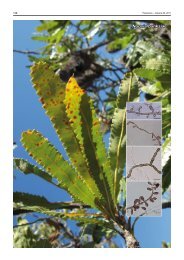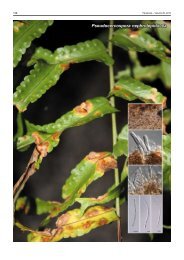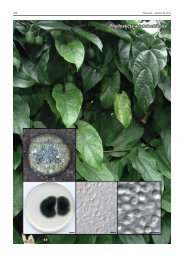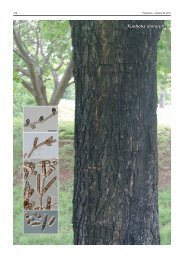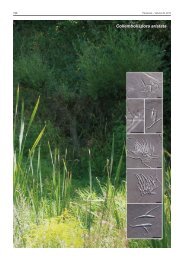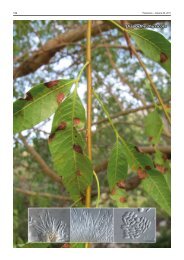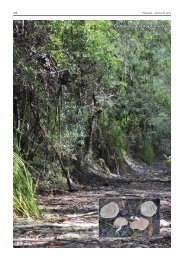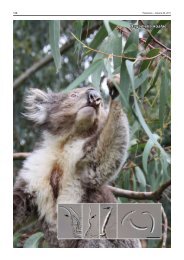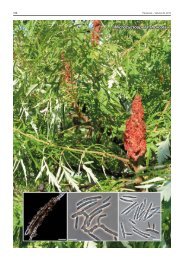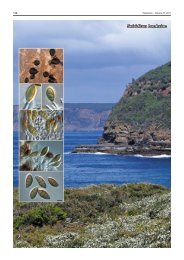Nectriella rusci - Fungal Planet
Nectriella rusci - Fungal Planet
Nectriella rusci - Fungal Planet
Create successful ePaper yourself
Turn your PDF publications into a flip-book with our unique Google optimized e-Paper software.
120 Persoonia – Volume 25, 2010<br />
<strong>Nectriella</strong> <strong>rusci</strong>
Persoonial Reflections<br />
121<br />
<strong>Fungal</strong> <strong>Planet</strong> 50 – 23 December 2010<br />
<strong>Nectriella</strong> <strong>rusci</strong> Lechat, Lowen & Gardiennet, sp. nov.<br />
Anamorph. Acremonium-like.<br />
Ascomata subglobosa, immersa, haud stromatica 180–220 μm diam,<br />
aurantia vel pallide luteis, immutabilia in 3 % KOH vel acido lactico. Paries<br />
peritheciorum 20–25 µm lata. Asci clavatos (53–)60–70(–75) × 8.5–10(–12)<br />
µm (m = 63.4 × 9.2 µm, n = 20), octospori, unitunicati, ascosporis biserialibus.<br />
Ascosporae ab ellipsoideis ad fusiformes (12.5–)13–14.5(–17) × 2.8–3.2 µm<br />
(m = 14.2 × 3 µm, n = 20), uniseptatae, hyalinae, spinosae. Status asexualis<br />
Acremonii similis.<br />
Etymology. The epithet <strong>rusci</strong> refers to the substratum Ruscus aculeatus.<br />
Ascomata scattered singly or in groups of 2–5, subglobose,<br />
180–220 µm diam, non-stromatic, totally immersed in host<br />
tissues, with only the rounded apex of papilla protruding at<br />
surface of periderm, at first orange-yellow, then pale yellow,<br />
not changing colour in 3 % KOH or lactic acid, completely<br />
covered by thick-walled, intertwined hyphae, except ostiolar<br />
region, 1.5–2.5 µm diam with wall 0.5–1 µm thick, hyaline.<br />
Apex of papilla composed of thin-walled, cylindrical to clavate<br />
cells, 8–12 × 2–2.8 µm. Ascomatal wall comprised of intertwined<br />
hyphae, 20–25 µm thick, of a single region composed<br />
of globose to ellipsoidal cells, 2.5–8 × 1.5–2.5 µm, hyaline<br />
to pale yellowish, thick-walled, wall 0.7–1.5(–2) µm thick, becoming<br />
narrower and thin-walled toward centre. Asci clavate,<br />
(53–)60–70(–75) × 8.5–10(–12) µm (av. = 63.4 × 9.2 µm,<br />
n = 20), short-stipitate, apex rounded with an inconspicuous<br />
refractive apical ring, usually containing biseriate ascospores,<br />
completely filling each ascus, numerous asci in which 2–4 of<br />
8 ascospores are aborted. Ascospores ellipsoidal to fusiform<br />
with rounded ends, (12.5–)13–14.5(–17) × 2.8–3.2 µm (av.<br />
= 14.2 × 3 µm, n = 20), 1-septate, not constricted at septum,<br />
hyaline, spinulose.<br />
Culture characteristics — Colony grown at 25 °C, on 2 %<br />
Difco potato-dextrose agar with 5 mg/L streptomycin, pale pinkish<br />
white, reaching 4–5 cm diam after 2 wk. Hyphae smooth,<br />
2–3 µm diam. Conidiophores long, subcylindrical, monophialidic<br />
70–100 µm long, 2–3 µm diam, 1–2-septate, simple or<br />
stalked with two secondary branches, sporulating in middle of<br />
colony, some orthophialides observed. Conidia ellipsoidal to<br />
subcylindrical, hyaline, smooth, non-septate, hyaline, smooth,<br />
(4.5–)5–12(–18) × 2.5–4.8(–5.2) µm (av. = 8.4 × 4.5 µm,<br />
n = 30). Abscission scar basal, minute.<br />
Typus. France, Côte d’Or, Messigny et Vantoux, on cladodes of Ruscus<br />
aculeatus, 12 Dec. 2009, A. Gardiennet, deposited at Faculté de Pharmacie<br />
de Lille, France (LIP) AG09358 holotype, culture ex-type CBS 126457,<br />
MycoBank MB516770.<br />
Notes — Through our ongoing research of hypocrealean<br />
fungi we discovered an undescribed species of <strong>Nectriella</strong> on<br />
the cladodes of Ruscus aculeatus. Although we have found<br />
many other hypocrealean fungi on this host, this is the first time<br />
a species of <strong>Nectriella</strong> is reported on Ruscus. <strong>Nectriella</strong> <strong>rusci</strong><br />
is difficult to see because it is totally immersed in the tissues<br />
of the host and possesses very small pale yellow ascomata.<br />
This fungus is not described in Lowen (1991)¹ and Rossman<br />
et al. (1999)²; we did not find any species corresponding to<br />
our specimen. <strong>Nectriella</strong> <strong>rusci</strong> resembles N. alpina because<br />
of the intertwined hyphal wall but differs from N. alpina by its<br />
smaller ascospores, (12.5–)13–14.5(–17) × 2.8–3.2 µm vs<br />
(12.5–)13–17.5(–19) × 3.5–5(–7) µm, and hosts, Arabidis or<br />
Saxifraga vs Ruscus aculeatus.<br />
Colour illustrations. Ascomata on host substratum; vertical section through<br />
ascomatal wall; asci and ascospores; conidiophore and conidia (C. Lechat).<br />
Scale bars = 10 μm.<br />
References. ¹Lowen R. 1991. A monograph of the genera <strong>Nectriella</strong><br />
Nitschke and Pronectria Clements with reference to Charonectria, Cryptonectriella,<br />
Hydronectria and Pseudonectria. PhD dissertation, City University<br />
of New York. ²Rossman AY, Samuels GJ, Rogerson CT, Lowen R. 1999.<br />
Genera of Bionectriaceae, Hypocreaceae and Nectriaceae (Hypocreales,<br />
Ascomycetes). Studies in Mycology 42: 1–248.<br />
Christian Lechat, Ascofrance, 64 route de Chizé, 79360 Villiers en Bois, France; e-mail: lechat@ascofrance.fr<br />
Rosalind Lowen P.O. Box 1223, Lincoln, NH 03251 USA; e-mail: Roz.lowen@gmail.com<br />
Alain Gardiennet, 14 rue roulette, 21260 Véronnes, France; e-mail: agardiennet@gmail.com<br />
© 2010 Nationaal Herbarium Nederland & Centraalbureau voor Schimmelcultures




